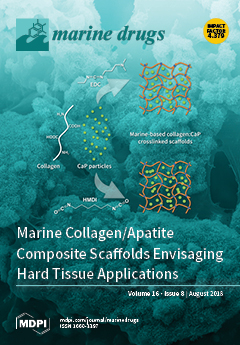Seven new secondary metabolites classified as two perylenequinone derivatives (
1 and
2), an altenusin derivative (
3), two phthalide racemates (
4 and
5), and two phenol derivatives (
6 and
7), along with twenty-one known compounds (
[...] Read more.
Seven new secondary metabolites classified as two perylenequinone derivatives (
1 and
2), an altenusin derivative (
3), two phthalide racemates (
4 and
5), and two phenol derivatives (
6 and
7), along with twenty-one known compounds (
8–
28) were isolated from cultures of the sponge-derived fungus,
Alternaria sp. SCSIO41014. The structures and absolute configurations of these new compounds (
1–
7) were determined by spectroscopic analysis, X-ray single crystal diffraction, chiral-phase HPLC separation, and comparison of ECD spectra to calculations. Altertoxin VII (
1) is the first example possessing a novel 4,8-dihydroxy-substituted perylenequinone derivative, while the phenolic hydroxy groups have commonly always substituted at C-4 and C-9. Compound
1 exhibited cytotoxic activities against human erythroleukemia (K562), human gastric carcinoma cells (SGC-7901), and hepatocellular carcinoma cells (BEL-7402) with IC
50 values of 26.58 ± 0.80, 8.75 ± 0.13, and 13.11 ± 0.95 μg/mL, respectively. Compound
11 showed selectively cytotoxic activity against K562, with an IC
50 value of 19.67 ± 0.19 μg/mL. Compound
25 displayed moderate inhibitory activity against
Staphylococcus aureus with an MIC value of 31.25 μg/mL.
Full article






